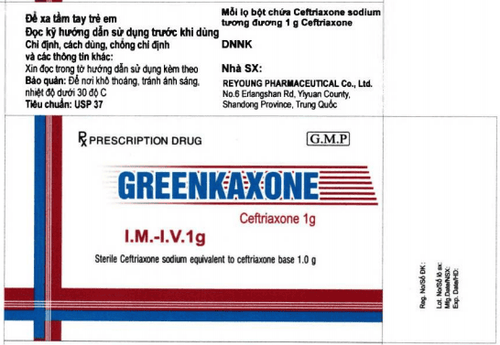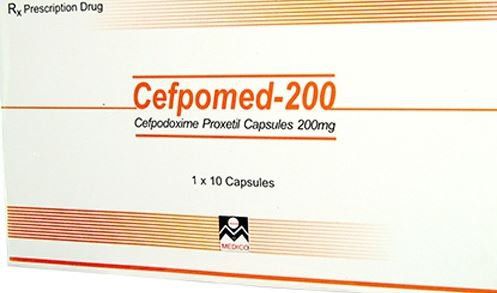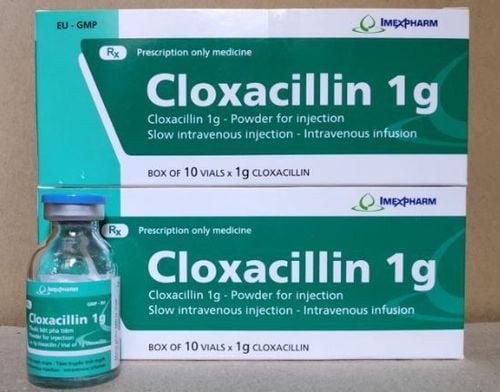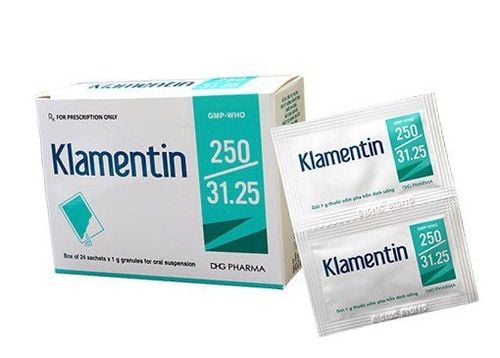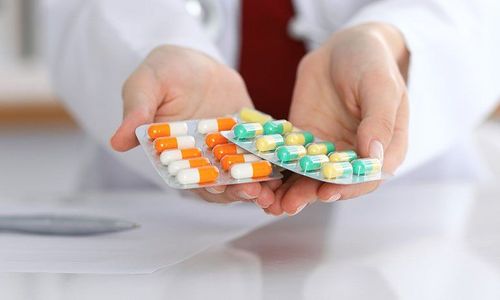This is an automatically translated article.
Bacforxime-1000 belongs to the group of anti-parasitic, anti-infective, anti-viral and fungal drugs, used to treat severe infections caused by bacterial strains. So what effect does Bacforxime-1000 have and in what specific cases is it used?1. What is Bacforxime 1000?
Bacforxime 1000 has the main active ingredient: Sodium Cefotaxime equivalent to Cefotaxime 1g, is prepared in the form of powder for injection, white color, bitter taste, special smell, packed in a box of 1 glass bottle with a stopper. sealed + 5ml distilled water for injection.
2. Uses of Bacforxime 1000
Bacforxime 1000 is used to treat serious infections caused by microorganisms sensitive to Cefotaxime active ingredient, including:
Bone / joint infections, blood infections, bacterial and coccidioid pericarditis, meningitis Brain. Skin and soft tissue infections, abdominal cavity, lower respiratory tract; Treatment of gonorrhea, urinary tract infections, obstetrics and gynecology. Prophylaxis of post-operative infections. Patients must absolutely not use Bacforxime 1000 when:
Are allergic or sensitive to Cefotaxime or to antibiotics of the Cephalosporin group. Lidocaine should not be administered intramuscularly to people with hypersensitivity, children under 30 months of age, heart block disease or severe heart failure.
3. How to use and dose Bacforxime 1000
How to use: The drug is prepared in the form of a powder for injection, so it should be administered intravenously or deep intramuscularly, injected slowly from 3-5 minutes or slow intravenous infusion from 20-60 minutes. The vial for injection is mixed with 5ml of distilled water for injection. Shake well to dissolve or mix into intravenous solution. Note, after mixing, the drug must be injected immediately.
Dosage: Dosage and administration of the drug should be based on the type of susceptible bacteria and the degree of infection, the patient's condition.
For adults:
Usual dose: Use from 3-6g, can be divided into 2 to 3 times. If the user has a severe bacterial infection, the dose can be increased to 12g per day, if the intravenous infusion is divided into 3 to 6 times. The usual dose for purulent infections (Pseudomonas aeruginosa) is over 6g a day. Note, do not use more than 12g a day. Treatment of gonorrhea: Use a single dose of 1g with intramuscular injection. Treatment of uncomplicated infections: 1g every 12 hours by intramuscular or intravenous infusion. For children: Use 100-150mg/kg body weight/day, divided dose into 2 to 4 times.
For infants: Use 50mg/kg body weight, divided into 2 to 4 times. In case of necessity, the dose can be increased to a maximum of 200mg/kg body weight/day, divided into 4 doses.
Used in the prevention of infection during surgery: Inject 1g dose 30 to 90 minutes before surgery. In case of caesarean section, inject 1g into the mother's vein immediately after clamping the placenta and after 6 to 12 hours, inject 2 more doses into the vein or muscle.
For people with renal failure : Used for people with a clearance of less than 10ml/min, after using the initial loading dose, it is necessary to reduce the dose by half but keep the number of doses in a day. The maximum dose for 1 day is 2g. Elderly patients need to adjust the dose according to the guidance of the doctor.
Time to take medicine: After the body temperature has returned to normal or when the infection is certain, the patient should still take the drug for another 3-4 days. If the drug is used to treat infections caused by group A beta-hemolytic streptococci, treatment for at least 10 days is required. In case of persistent infection, treatment may be required for several weeks.
4. How to handle when forgetting / overdose Bacforxime-1000
In case of a missed dose, the patient should skip the missed dose and continue taking the next dose at the same time and dose as previously indicated. It is strictly forbidden to take a double dose to make up for the missed dose.
In case of overdose:
User may experience severe or prolonged diarrhea. If this is the case, the drug should be stopped and replaced with another antibiotic that is clinically effective for C. difficile colitis. If you experience symptoms of poisoning, users need to stop using Cefotaxime and go to the hospital for treatment. Treatment: use peritoneal dialysis or dialysis to reduce the concentration of cefotaxime in the blood.
5. Side effects of Bacforxime 1000
When using Bacforxime, in addition to the main effects that the drug brings, users may experience some unwanted symptoms as follows:
Common cases:
Digestive system effects: Diarrhea. Local effects: Thrombophlebitis, pain and inflammatory reaction at the site of intramuscular injection. Rare cases:
Effects on blood: Decrease in eosinophils or white blood cells, making Coombs test positive. Effects on the digestive system: Changes in bacteria in the intestine, possible superinfection due to drug-resistant bacteria such as Enterobacter, Pseudomonas aeruginosa,... Rare cases:
Systemic: Causes anaphylaxis, reactions hypersensitivity reaction. Effects on blood: Agranulocytosis/platelets, anemia, hemolysis. Gastrointestinal effects: Clostridium difficile pseudomembranous colitis, increased plasma bilirubin and liver enzymes. Note: When users need more information about the drug, please consult a doctor and immediately report any unwanted effects encountered when using the drug.
6. Bacforxime 1000 . drug interactions
Bacforxime may interact with other supplements, drugs and foods such as:
Colistin and Cephalosporins: There may be an increased risk of kidney damage when Bacforxime is taken together with these Polymyxin groups of antibiotics. Uredo-penicillins and Cefotaxime: May decrease the clearance of the active substance Cefotaxime in patients with impaired or normal renal function. It is necessary to reduce the amount of Cefotaxime if used in combination. Active ingredient Cefotaxime increases the nephrotoxicity of active ingredient Cyclosporin. Note: In order to minimize unwanted symptoms, patients need to talk to their doctor about functional foods and drugs they are using to get the best and most appropriate dose.
7. Some notes when using Bacforxime 1000
Absolutely do not use water for injection containing the active ingredient lidocaine to mix Cefotaxime intravenously, only for intramuscular use. Before using Cefotaxime for treatment, it is necessary to determine the history of the patient who has had hypersensitivity reactions to the active substance Cephalosporin and derivatives of Penicillin, Cephalosporin or some other drugs. When administering the drug to patients with renal impairment, it is necessary to reduce the daily dose. When used in combination with drugs capable of causing nephrotoxicity, it is necessary to check and monitor renal function regularly. When taking the drug can cause false positive results with the Coombs test, a urine test. Subjects are pregnant and lactating women need to be cautious when using the drug. Absolutely do not use the drug when it has expired, there are signs of color change, moisture, blurred labels or any doubt that requires asking the place of sale. Hopefully, the information shared above about the uses - indications, doses as well as some notes of Bacforxime 1000 will help patients know more information and feel more secure when using it.
Please dial HOTLINE for more information or register for an appointment HERE. Download MyVinmec app to make appointments faster and to manage your bookings easily.




